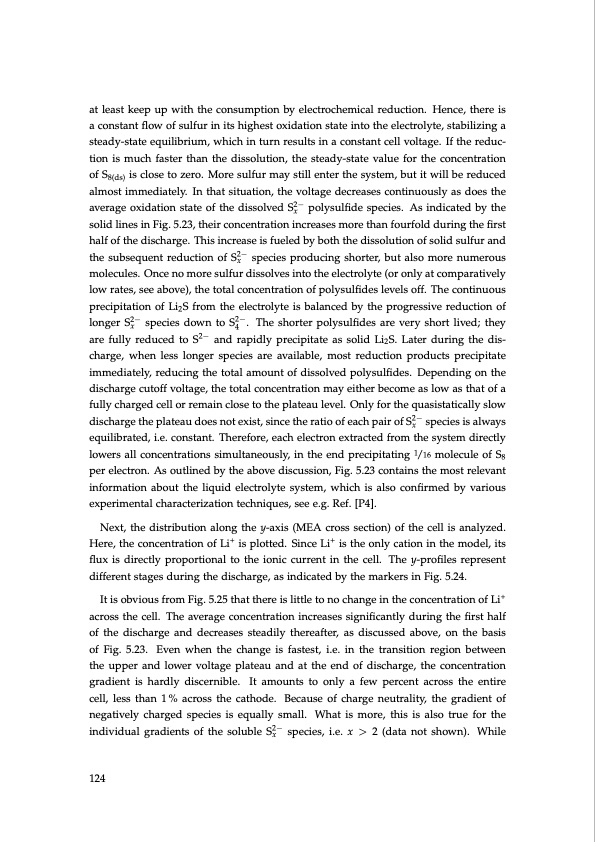
PDF Publication Title:
Text from PDF Page: 124
at least keep up with the consumption by electrochemical reduction. Hence, there is a constant flow of sulfur in its highest oxidation state into the electrolyte, stabilizing a steady-state equilibrium, which in turn results in a constant cell voltage. If the reduc- tion is much faster than the dissolution, the steady-state value for the concentration of S8(ds) is close to zero. More sulfur may still enter the system, but it will be reduced almost immediately. In that situation, the voltage decreases continuously as does the average oxidation state of the dissolved S2− polysulfide species. As indicated by the x solid lines in Fig. 5.23, their concentration increases more than fourfold during the first half of the discharge. This increase is fueled by both the dissolution of solid sulfur and the subsequent reduction of S2− species producing shorter, but also more numerous x molecules. Once no more sulfur dissolves into the electrolyte (or only at comparatively low rates, see above), the total concentration of polysulfides levels off. The continuous precipitation of Li2S from the electrolyte is balanced by the progressive reduction of longer S2− species down to S2−. The shorter polysulfides are very short lived; they x4 are fully reduced to S2− and rapidly precipitate as solid Li2S. Later during the dis- charge, when less longer species are available, most reduction products precipitate immediately, reducing the total amount of dissolved polysulfides. Depending on the discharge cutoff voltage, the total concentration may either become as low as that of a fully charged cell or remain close to the plateau level. Only for the quasistatically slow discharge the plateau does not exist, since the ratio of each pair of S2− species is always x equilibrated, i.e. constant. Therefore, each electron extracted from the system directly lowers all concentrations simultaneously, in the end precipitating 1/16 molecule of S8 per electron. As outlined by the above discussion, Fig. 5.23 contains the most relevant information about the liquid electrolyte system, which is also confirmed by various experimental characterization techniques, see e.g. Ref. [P4]. Next, the distribution along the y-axis (MEA cross section) of the cell is analyzed. Here, the concentration of Li+ is plotted. Since Li+ is the only cation in the model, its flux is directly proportional to the ionic current in the cell. The y-profiles represent different stages during the discharge, as indicated by the markers in Fig. 5.24. It is obvious from Fig. 5.25 that there is little to no change in the concentration of Li+ across the cell. The average concentration increases significantly during the first half of the discharge and decreases steadily thereafter, as discussed above, on the basis of Fig. 5.23. Even when the change is fastest, i.e. in the transition region between the upper and lower voltage plateau and at the end of discharge, the concentration gradient is hardly discernible. It amounts to only a few percent across the entire cell, less than 1% across the cathode. Because of charge neutrality, the gradient of negatively charged species is equally small. What is more, this is also true for the individual gradients of the soluble S2− species, i.e. x > 2 (data not shown). While x 124PDF Image | Lithium-Sulfur Battery: Design, Characterization, and Physically-based Modeling

PDF Search Title:
Lithium-Sulfur Battery: Design, Characterization, and Physically-based ModelingOriginal File Name Searched:
Dissertation_David_N._Fronczek_The_Lithium_Sulfur_Battery.pdfDIY PDF Search: Google It | Yahoo | Bing
Sulfur Deposition on Carbon Nanofibers using Supercritical CO2 Sulfur Deposition on Carbon Nanofibers using Supercritical CO2. Gamma sulfur also known as mother of pearl sulfur and nacreous sulfur... More Info
CO2 Organic Rankine Cycle Experimenter Platform The supercritical CO2 phase change system is both a heat pump and organic rankine cycle which can be used for those purposes and as a supercritical extractor for advanced subcritical and supercritical extraction technology. Uses include producing nanoparticles, precious metal CO2 extraction, lithium battery recycling, and other applications... More Info
| CONTACT TEL: 608-238-6001 Email: greg@infinityturbine.com | RSS | AMP |